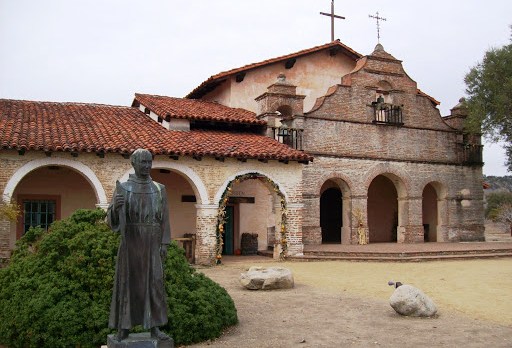The canonization of Blessed Junipero Serra, announced by Pope Francis last week, is a “long overdue” honor to a great missionary who spent his life to bring the Gospel to the native peoples of North America.
That was the reaction of the longtime archivist of the Archdiocese of Los Angeles, Msgr. Francis J. Weber, a priest who has spent some 60 years researching the life of the Spanish missionary known as the “Apostle of California.”
“In September, God willing, I will canonize Junipero Serra in the United States,” Pope Francis told journalists on his flight to the Philippines Jan. 15. “He was the evangelizer of the West in the United States.”
The news caught everyone by surprise. Not only will it be the first canonization ever performed on U.S. soil; it will be performed without the customary requirement of a second miracle. Francis explained why, during his in-flight press conference.
“It is used when, over many years, a man or a woman is blessed and is venerated by the people of God; and, in practice, this person is venerated as a saint,” the Pope said. “These are people who, for centuries, perhaps, are in this way [witnesses of holiness.”
He listed several saints he has canonized recently in this way, including the latest, St. Joseph Vaz, in Sri Lanka.
“These are people who did a lot of evangelization and who are in line with the spirituality and theology of Evangelii Gaudium,” he said, referring to his 2013 apostolic exhortation The Joy of the Gospel. “That is the reason why I chose them.”
Monday, on his way back to Rome from the Philippines, the Pope said he would like to perform the ceremony in California, where Serra is buried, but that because of time limitations, he would likely perform the canonization at the Basilica of the National Shrine of the Immaculate Conception in Washington, D.C. He mentioned that there is a statue of Serra in Statuary Hall in the U.S. Capitol in Washington.
The announcement “came as a surprise,” said Franciscan Father John Vaughn, former master general of the Franciscans who is now vice-postulator of the cause of canonization for Junipero Serra. “We’ve been working on the cause for quite a few years and we felt that perhaps we were nearing some type of an announcement. We didn’t know when or where.”
Msgr. Weber, author of Life and Times of Fray Junipero Serra (1987), described Serra as someone who lived the virtues in a heroic manner—”and in the process brought the message of Christianity… He did it before freeways, so it wasn’t very easy. At that time, California was on what they called the ‘rim of Christendom.’”
The one-time rector of the San Fernando Mission, one of the nine missions founded by Serra, Msgr. Weber is confident that the saint’s reputation for holiness will overcome whatever controversy persists about the alleged mistreatment of Native Americans under his purview.
“People allege that [Serra beat Indians] but there’s no documentation anywhere in any of the writings of the time that he did that,” Msgr. Weber said. “In fact he was known for just the opposite. At one time, when a Native American broke into one of the missions and killed one of the missionaries, the military wanted to put the Indian to death, but Serra intervened.”
He charges that the controversy was started a few years ago by “people who didn’t know much history…. There’s nothing anywhere that would indicate that he did this.”
Steven Hackel, professor of history at the University of California Riverside and author of Junipero Serra: California’s Founding Father, said that there is evidence that Serra engaged in penitential self-flagellation, but “we don’t have any smoking gun that Serra himself beat Native Americans.”
He did, however, write in defense of the use of corporal punishment as a way to guide the “spiritual children” of the Franciscan missionaries in the spiritual life, said Hackel.
Nevertheless, he was not a “genocidal maniac,” as some charge, the historian said.
More important to Msgr. Weber is Serra’s example of sacrifice for the Gospel.
“He was a university professor in Spain, but he gave up his position to come to California to teach the Native Americans about the Lord,” he said. “None of the languages in California at the time—there were over 30 of them—had a word for ‘trinity.’ The fact that he could change gears and start relating to an aboriginal culture was almost miraculous in itself.”
The Franciscan missionary also undertook several arduous journeys, walking long distances on behalf of his spiritual charges.
“I was there when we exhumed him in 1984,” Msgr. Weber said. “You could see on the bone of the leg, he had cancer of the leg, and he walked on that leg all those miles, a long, hard journey…. This is a man who people say didn’t like Indians. Why else would he come to California? He wasn’t going to get a pay raise. There was no attraction here for him if he didn’t have a supernatural motivation.”
Hackel was a co-curator of an exhibit on Junipero Serra at the Huntington Library on the occasion of the 300th anniversary of Serra’s birth, last year. Msgr. Weber also mounted an exhibit at San Fernando, which he said, he’d been considering dismantling soon. With the Pope’s announcement, however, he said he’d leave the display up for a while.
“It’s getting a lot of local press,” he said.
John Burger is news editor for Aleteia’s English edition.

